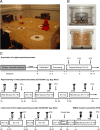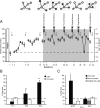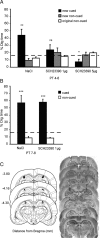Dopamine and memory: modulation of the persistence of memory for novel hippocampal NMDA receptor-dependent paired associates
- PMID: 20130171
- PMCID: PMC6633999
- DOI: 10.1523/JNEUROSCI.2721-09.2010
Dopamine and memory: modulation of the persistence of memory for novel hippocampal NMDA receptor-dependent paired associates
Abstract
Three experiments investigated the role in memory processing of dopamine (DA) afferents to the hippocampus (HPC) that arise from the ventral tegmental area. One hypothesis is that D(1)/D(5) receptor activation in HPC is necessary for the encoding of novel, episodic-like information; the other is that DA activation ensures the greater temporal persistence of transient hippocampal memory traces. Rats (n = 35) were trained, in separate experiments using an episodic-like memory task, to learn six paired associates (PAs) in an "event arena" involving a repeated association between specific flavors of food and locations in space. After 6 weeks of training, rats had learned a "schema" such that two new paired associates could be acquired in a single trial in one session (episodic-like memory). We show that encoding of novel PAs is sensitive to intrahippocampal microinfusion of the NMDA antagonist d-AP-5. Experiment 1 established that intrahippocampal infusion of the D(1)/D(5) dopaminergic antagonist SCH23390 [R(+)-7-chloro-8-hydroxy-3-methyl-1-phenyl-2,3,4,5-tetrahydro-1H-3-benzazepine hydrochloride] before encoding of new PAs caused impaired memory 24 h later but that SCH23390 had no effect on the later memory of previously established PAs. Experiment 2 established that SCH23390 modulated the persistence of new memories over time (30 min vs 24 h) rather than affecting initial encoding. Experiment 3 revealed that the impact of SCH23390 was not mediated by state dependence nor had an effect on memory retrieval. These findings support the second hypothesis and establish that persistent, long-term memory of rapid, hippocampal-mediated acquisition of new paired associates requires activation of D(1)/D(5) receptors in HPC at or around the time of encoding.
Figures





Similar articles
-
Dopaminergic modulation of the persistence of one-trial hippocampus-dependent memory.Learn Mem. 2006 Nov-Dec;13(6):760-9. doi: 10.1101/lm.321006. Learn Mem. 2006. PMID: 17142305 Free PMC article.
-
Dopamine controls persistence of long-term memory storage.Science. 2009 Aug 21;325(5943):1017-20. doi: 10.1126/science.1172545. Science. 2009. PMID: 19696353
-
Roles of NMDA and dopamine D1 and D2 receptors in the acquisition and expression of flavor preferences conditioned by oral glucose in rats.Neurobiol Learn Mem. 2014 Oct;114:223-30. doi: 10.1016/j.nlm.2014.07.004. Epub 2014 Jul 25. Neurobiol Learn Mem. 2014. PMID: 25065714
-
Dopamine D1 receptor activity modulates object recognition memory consolidation in the perirhinal cortex but not in the hippocampus.Hippocampus. 2013 Oct;23(10):873-8. doi: 10.1002/hipo.22143. Epub 2013 Jun 11. Hippocampus. 2013. PMID: 23674387
-
Elements of a neurobiological theory of hippocampal function: the role of synaptic plasticity, synaptic tagging and schemas.Eur J Neurosci. 2006 Jun;23(11):2829-46. doi: 10.1111/j.1460-9568.2006.04888.x. Eur J Neurosci. 2006. PMID: 16819972 Review.
Cited by
-
The HexMaze: A Previous Knowledge Task on Map Learning for Mice.eNeuro. 2021 Aug 11;8(4):ENEURO.0554-20.2021. doi: 10.1523/ENEURO.0554-20.2021. Print 2021 Jul-Aug. eNeuro. 2021. PMID: 34135006 Free PMC article.
-
Dopamine D1/D5, But not D2/D3, Receptor Dependency of Synaptic Plasticity at Hippocampal Mossy Fiber Synapses that Is Enabled by Patterned Afferent Stimulation, or Spatial Learning.Front Synaptic Neurosci. 2016 Sep 23;8:31. doi: 10.3389/fnsyn.2016.00031. eCollection 2016. Front Synaptic Neurosci. 2016. PMID: 27721791 Free PMC article.
-
Weak reward source memory in depression reflects blunted activation of VTA/SN and parahippocampus.Soc Cogn Affect Neurosci. 2014 Oct;9(10):1576-83. doi: 10.1093/scan/nst155. Epub 2013 Sep 26. Soc Cogn Affect Neurosci. 2014. PMID: 24078019 Free PMC article.
-
Abnormal relationship between medial temporal lobe and subcortical dopamine function in people with an ultra high risk for psychosis.Schizophr Bull. 2012 Sep;38(5):1040-9. doi: 10.1093/schbul/sbr017. Epub 2011 May 2. Schizophr Bull. 2012. PMID: 21536784 Free PMC article.
-
Distinct roles of dopamine and subthalamic nucleus in learning and probabilistic decision making.Brain. 2012 Dec;135(Pt 12):3721-34. doi: 10.1093/brain/aws273. Epub 2012 Oct 31. Brain. 2012. PMID: 23114368 Free PMC article.
References
-
- Adcock RA, Thangavel A, Whitfield-Gabrieli S, Knutson B, Gabrieli JD. Reward-motivated learning: mesolimbic activation precedes memory formation. Neuron. 2006;50:507–517. - PubMed
-
- Bernabeu R, Bevilaqua L, Ardenghi P, Bromberg E, Schmitz P, Bianchin M, Izquierdo I, Medina JH. Involvement of hippocampal cAMP/cAMP-dependent protein kinase signaling pathways in a late memory consolidation phase of aversively motivated learning in rats. Proc Natl Acad Sci U S A. 1997;94:7041–7046. - PMC - PubMed
-
- Bliss TV, Collingridge GL. A synaptic model of memory: long-term potentiation in the hippocampus. Nature. 1993;361:31–39. - PubMed
-
- Bontempi B, Laurent-Demir C, Destrade C, Jaffard R. Time-dependent reorganization of brain circuitry underlying long-term memory storage. Nature. 1999;400:671–675. - PubMed
-
- Buhot MC, Martin S, Segu L. Role of serotonin in memory impairment. Ann Med. 2000;32:210–221. - PubMed
Publication types
MeSH terms
Substances
Grants and funding
LinkOut - more resources
Full Text Sources
Other Literature Sources
Medical
